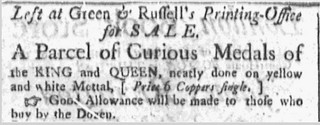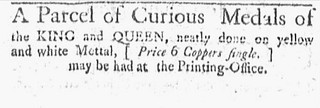
PREV ARTICLE
NEXT ARTICLE
FULL ISSUE
PREV FULL ISSUE
GREEN & RUSSELL, COLONIAL BOSTON MEDAL DEALERS
John Lupia submitted the following information for this week's installment of his series on numismatic biographies. Thanks!
He's been working for years researching 18th century American numismatists and dealers, and has uncovered quite a bit of information that pushes back our knowledge of this area by over a century. His book will be titled Numismatic Collecting in 18th Century America. This week's subject is the firm of Green & Russell, colonial Boston auctioneers and medal dealers. As always, this is an excerpt with the full article and bibliography available online. -Editor

Boston Post-Boy, Monday, February 15, 1762, page 3.
“Left at Green & Russell’s Printing-Office for SALE. A Parcel of Curious Medals of the KING and QUEEN, neatly done in yellow and white Mettal, [Price 6 Coppers single,] ☞ Good Allowance will be made to those who buy by the Dozen.”

Boston News-Letter, Thursday, February 11, 1762, page 3. "A Parcel of Curious Medals of the KING and QUEEN, neatly done on yellow and white Mettal, [Price 6 Coppers single,] may be had at the Printing-Office." An unspecified quantity of medals was left at “Green & Russell’s Printing Office”, which is the office of the publishers John Green (1715/7-1787), and Joseph Russell (1734-1795), of the newspaper the Boston Post-Boy and Advertiser, the successor to or continuation of their former paper, Boston Weekly Advertiser (1757-1759). John Green was born in 1717 at Boston the son of Bartholomew Green, Jr. His great-grandfather Bartholomew Green who came to America in 1632 together with his grandfather Samuel Green of Cambridge printed the Indian Bible. He was an apprentice to the printer John Draper who published the Boston News-Letter. Green died in November 1787. Green and Russell formed a partnership in 1755. “A few years afterward, Russell opened an auction office, the profits of which were shared by the firm. Green managed the printing office and Russell took charge of the auction room.” Russell had been an auctioneer in Boston at least four if not five years by this time. He was the most prominent auctioneer in Boston. Isaiah Thomas credits only Joseph Russell as auctioneer but reading through the newspapers frequently the auctions advertised give J. G., Auctioneer. Apparently both men were active in auction sales at their office. Anyone reading this advertisement to come to the “Green & Russell’s Printing Office”, would know and understand it was Green’s and Russell’s auction store. Undoubtedly, the parcel containing the medals was consigned to either twenty-eight year old Joseph Russell or forty-five year old Green to auction them off in larger quantities in batches based on a unit of a dozen since there was no fixed price for bulk lots. The only fixed price established in the advertisement was 6 coppers for a single medal. Since we know copper farthings and halfpence were in circulation at Boston at this time it seems tenable that the price set for a single medal was one and a half penny or 6 farthings. Apparently that was the high end of the market price for one and a retailer buying by the dozen or gross would expect to pay only a fraction of that in order to turn over a profit. It is in this variability that auction bids, either in a live public auction forum or silent auction or sealed bids, typically called a private sale that determined at what rate buyers were to pay per item. The above cited medal auction was inadvertently deleted from my book manuscript that was published as American Numismatic Auctions to 1875, Volume 1 : 1738-1850. Since publication new material has been collected and a fuller completely revised edition is planned to be published either separately or combined with Volume 2 : 1851-1875. This auction should have been entry No. 9, Coin Auction No. 4. These earliest auctions from 1738-1762 were of numismatic literature, scrip, King of Prussia medals, freemason medals, and English medals of the King and Queen. Those who bought my book might want to print this page as an additional addendum. Apologies to all; mea culpa, mea culpa, mea maxima culpa. The Wedding Medal that Green & Russell sold is not precisely known but is perhaps identical with that formerly in the DiLauro Collection, now in the ANS, as described below or those in brass and pewter in the British Museum. There were numerous Wedding Medals struck in great variety complicating the identification of which medal precisely was sold at Boston in February 1762, five months (115 days) after their distribution at London. Considering the voyage from London to Boston averaged about seven weeks, this shipment must have left London about two months after the wedding suggesting these were the remaining unsold pieces seeking a market elsewhere by those patented to mint or sell them. The costs of manufacture, shipping and distribution of these medals was probably about half the price, which in 1762 Boston, Green & Russell set at the high end of one and a half penny. A shopkeeper had an incentive to purchase a dozen or more at wholesale since he could turn over a reasonable profit. The scarcity of American surviving specimens is most probably attributed to the rebels during the Revolutionary War who would have either aimlessly destroyed them or melted them to make utensils. George III (reign 1760-1820), married Princess Charlotte Sophia (1744-1818), daughter of Louis Frederick, Duke of Mecklenburg-Strelitz on September 8, 1761. Sir Joshua Reynolds was commissioned to paint the marriage scene inside Westminster Abbey. The royal engravers were given the task to produce a series of commemorative medals to celebrate the event. The medals were distributed on Tuesday, September 22, 1761 at the coronation ceremony in Westminster Abbey. The various varieties (BHM 12 and 17, Jamieson 10, Betts 440, etc.) correspond to the intended recipients. Those struck in gold and silver were given to the nobility. Those in bronze, brass, pewter are most probably those here described as white metal for the masses. There were several wedding medals issued and one or more is cited in this ad. The description given in this ad fails to elucidate either the quantity or any physical description or legend to assist in identifying a specific variety. The British Museum has brass and pewter wedding medals fitting the description published in this auction advertisement as “yellow and white metal,” M.4679 (brass), 1906,1103.398 (brass); and M.4642 (pewter). The ANS has one in white metal 1975.248.2 (BHM 34), donated from the DiLauro Collection. This DiLauro specimen is most probably a survivor of the many dozens that were sold in this auction sale. The BHM 48 issued in brass and copper was designed by an unidentified engraver. Besides the brass and pewter medals others, as we have already noted, were struck in gold, silver and bronze.
To read the complete article, see:
The Numismatic Bibliomania Society is a non-profit organization promoting numismatic literature. See our web site at coinbooks.org. To submit items for publication in The E-Sylum, write to the Editor at this address: whomren@gmail.com To subscribe go to: https://my.binhost.com/lists/listinfo/esylum All Rights Reserved. NBS Home Page Contact the NBS webmaster 
|